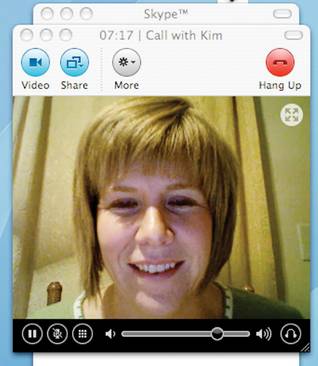
Kimberly Townsend Little earned a doctorate from UNLV by taking online classes from her home in North Carolina. She learned to use Skype, above, one of several free online services that allow people to talk to and see each other.
Monday, Dec. 28, 2009 | 2 a.m.
Beyond the Sun
Kimberly Townsend Little walked the stage at UNLV’s winter commencement ceremonies this month and picked up her doctorate in nursing.
For her, it was a rare visit to the campus.
She lives in North Carolina and completed her course work entirely online.
For Little, leaving home in pursuit of her doctorate wasn’t an option. She is not only an assistant professor of nursing education at Cabarrus College of Health Sciences in Concord, N.C., but also a single mother of three daughters — ages 17, 10 and 5.
“I’m extremely grateful to UNLV,” Little said. “It’s been a wonderful opportunity.”
UNLV offers five degree programs in which the required classes are entirely online, including a master’s in hospitality administration and a master’s in leadership preparation for educators. A new online doctoral program in nursing practice will be offered jointly with UNR beginning next fall.
Of the 34 students enrolled this fall in the nursing education doctoral program, 17 live out of state. Their combined tuition brings in more than $600,000 in premium revenue: Nevada students pay $8,883 per year while out-of-state tuition is $27,393.
Carolyn Yucha, dean of nursing for UNLV, said the doctoral program is highly competitive, and accepts about eight to 10 new students each year, usually older adults who have jobs, mortgages and families that make a traditional doctoral track difficult to balance.
With a shortage of nursing faculty in Nevada and across the country, UNLV is helping to fill a crucial gap by offering the degree online, Yucha said.
Instead of face-to-face instruction by a professor standing at the front of a lecture hall, online instruction is more flexible in its delivery. Some classes allow students to download lectures and study at their own pace, while others require students to “log on” at a specific time for group discussions or exams.
Distance education has grown at a staggering rate in the past decade at the nation’s colleges and universities, and UNLV is no exception. Eighty-eight percent of four-year institutions offer online classes, up from 12 percent in 1998, said Mark Fink, instructional design coordinator for UNLV.
During the 2008-09 academic year, UNLV filled more than 26,000 online seats in about 400 classes, said Fink, who helps professors with both the technical and instructional development of online classes.
It’s not just out-of-state students such as Little who benefit.
“We have students with a two-year degree from a community college who wants to advance, but can’t leave Tonopah to drive to Las Vegas to attend a class,” Fink said. “We offer them the same access to education.”
Even though students who are bound as much by time constraints as geography benefit from the flexibility of online classes, UNLV’s program holds them to the same academic expectations as their peers in traditional classrooms. Students must complete all of their work by the end of the term, and also participate in regular digital discussions with classmates and professors.
In a bricks-and-mortar classroom, students often only participate when called on by the professor. Online discussions often draw in a broader spectrum of the students and result in richer exchanges of ideas, Fink said.
There were days when Little, at home in North Carolina, wished she had the option of popping into a professor’s office to talk about a project. But she learned to make the most of e-mail, phone calls and video conferencing using Skype, one of several free online services that allow people to talk to — and see — each other. And each fall she spent a week at UNLV, as required by her program, which gave her an opportunity for face-to-face interaction.
She was also required to teach an online course of her own to UNLV undergraduates, with a faculty member keeping tabs on her progress.
In her class on nutrition, growth and development, Little had 40 students “and I never met even one of them,” she said with a laugh.
UNLV President Neal Smatresk said the fact that out-of-state students such as Little find their way to UNLV speaks to the university’s “global brand.” And although she might not put her newly acquired doctorate to work locally, it’s still a boon to the community. UNLV has more out-of-state enrollments than the rest of the Nevada System of Higher Education combined, and their nonresidential tuition helps to keep costs down for local students and improves access to higher education.
One of his big goals for 2010 will be to boost nonresidential enrollment even further, including by offering more innovative programs that attract students such as Little.
“We have a chance to have them participate in our economy,” Smatresk said. “There isn’t a state that doesn’t want that.”

Join the Discussion:
Check this out for a full explanation of our conversion to the LiveFyre commenting system and instructions on how to sign up for an account.
Full comments policy